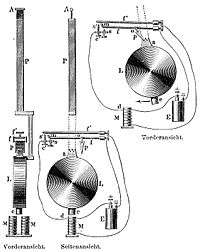Matthias Hipp
Matthäus Hipp also Matthias or Mathias (Blaubeuren, 25 October 1813 – 3 May 1893 in Fluntern) was a German clockmaker and inventor who lived in Switzerland.[1][2] His most important, lastingly significant inventions were electrical looms, traffic signals, and pendulum clocks as well as Hipp's Chronograph.
Biography
The son of grain millers at a monastery, Hipp was born 25 October 1813 in Blaubeuren (Württemberg). At the age of eight, he had an accident climbing on one of the many rocks there and was lame for the rest of his life. At the age of sixteen, he became apprenticed to Johan Eichelhofer in Blaubeuren. At the conclusion of his apprenticeship he began his Wanderjahre. In 1832 after working in Ulm for clockmaker Valentin Stoß, in 1834 he worked in St. Gallen, afterwards between 1835 and 1837 in the Uhrenfabrik Savoie in St. Aubin on Neuenburger See. In 1840, he came to Reutlingen and opened a workshop there in 1841, when he was 28. In the same year he married a teacher's daughter Johanna Plieninger. The married couple had four children.
After the suppressed revolution in Baden in the year 1849 his application for director of the clockmaker school in Furtwangen was rejected for political reasons, because he was regarded as a democrat. Consequently, in 1852, Hipp decided to leave Germany. He was appointed by the Swiss government as the director of the national telegraph workshop and technical director of the telegraph administration. Although Hipp's agreement explicitly allowed him to also continue working privately, when his privately derived income far exceeded his salary for public service, there arose conflicts with the Swiss administration and parliament. Hipp responded in 1860 by resigning from the Swiss government service.
The next part of his life career led him from Bern to Neuchâtel, where he took over the directorship of a newly established telegraph factory. Not until 1889 did Hipp relinquish management and hand over control of the company to the engineers A. Favarger and A. De Peyer. From then until 1908 the factory carried the logo "Peyer & Favarger, Succ. de M. Hipp".
Soon after his retirement he moved to Fluntern to be near his daughter in Zürich. On 3 May 1893, Matthäus Hipp died at the age of eighty in Fluntern. His wife outlived him by four years. Hipp, who since 1852 lived and worked in Switzerland, but never gave up his previous nationality, received the honorary name of "the Swiss Edison".
Achievements


Matthäus Hipp in the course of 40 years brought more than 20 inventions to technical maturity. Some of his inventions proved so good that for approximately one hundred years without changes in basic design these inventions could be manufactured and sold. For its time, Hipp's electrical pendulum clock was a technological breakthrough.
- 1843 description of a pendulum clock driven by a special escapement called "echappement à palette".[3]
- 1847 Chronoscope [4][5]
- 1854 Two-way telegraphy on the same line
- 1855 Electrical loom
- 1856 He laid a cable of his own construction from Vierwaldstättersee to Flüelen
- 1862 Hipp's "Wendescheibe", an automatic visual traffic signal
- 1862 He installed a clock system with an ultra-precise master clock and slave clocks in Geneva
- 1863 May 27 French patent for an electrical driven pendulum clock with hipp-toggle: "Pendule ou horloge électro-magnétique à appal direct d’électricité"
- 1866 He developed in collaboration with Frédéric William Dubois an electrical Registrierchronographen with marine chronometer
- 1867 electrical clavier
- 1874 He delivered to Vienna a chronograph for the observation of nerve activity
- 1881 High precision electrical observatory clock for the Observatoire Cantonal de Neuchâtel
- 1889 Registering speedometers
Honors
- 1840 high Württemberg honor „für sein im Uhrenbau neues, sinnreiches Prinzip zur Erzielung eines gleichformigen Pendelgangs“ (for his ingenious principle for the achievement of a homogeneous pendulum escapement, new in the building of clocks)
- 1873 Ritterkreuz of the Austrian Order of Franz Joseph
- 1875 Ehrendoktorwürde (Dr. phil. E. h.) from the Universität Zürich.
References
- ↑ Matthäus Hipp. In: Curt Dietzschold: Der Cornelius Nepos der Uhrmacher. Krems 1910, S. 51
- ↑ Jürgen Abeler: Meister der Uhrmacherkunst. Wuppertal 1977, S. 281.
- ↑ Hipp, Matth.(aeus): Sich selbst controlirende Uhr, welche augenbliklich anzeigt, wenn die durch Reibung etc. verursachte Unregelmäßigkeit im Gang auch nur den tausendsten Theil einer Secunde ausmacht und welche ein mehr als hundertfach größeres Hinderniß überwindet, ehe sie stehen bleibt, als andere Uhren, in: Polytechnisches Journal 88, 1843, p. 258-264, 441-446 and sheet Taf. IV and V
- ↑ Caspar Clemens Mierau: Matthias Hipp und das "Hipp'sche Chronoskop"
- ↑ Thomas Schraven: The Hipp Chronoscope PDF 2.81 MB
- Hans Rudolf Schmid (1972), "Hipp, Matthäus", Neue Deutsche Biographie (NDB) (in German) 9, Berlin: Duncker & Humblot, pp. 199–200; (full text online)
- Hipp, Matthias in German, French and Italian in the online Historical Dictionary of Switzerland.
- Helmut Kahlert: Lorenz Bob und Matthäus Hipp in „Alte Uhren und moderne Zeitmessung“; Verlag Callwey München; Nr.4 1987 S.22f
- G. H. Baillie: Watchmakers & Clockmakers of the World; ISBN 1-4067-9113-X
- R. Weber, L. Favre: Matthäus Hipp : 1813-1893, Bulletin de la Société des Sciences Naturelles de Neuchâtel, Band 24 (1895-1896), S.212f SEALS
External links
| Wikimedia Commons has media related to Matthäus Hipp. |
| Wikimedia Commons has media related to Hipp's Wendescheibe. |
- Stadt Blaubeuren: Berühmte Köpfe
- Die Entwicklungsgeschichte der Elektrischen Uhren: Matthäus Hipp
- Tram-Museum Zürich: Der registrierende Geschwindigkeitsmesser System Hipp
- watch-wiki: Matthäus Hipp
- Video of the Wendescheibe model SchBB, which shows its function
- The Electro-Mechanical Piano Matthias Hipps and the Electro-Mechanical Piano on '120 years Of Electronic Music'
|